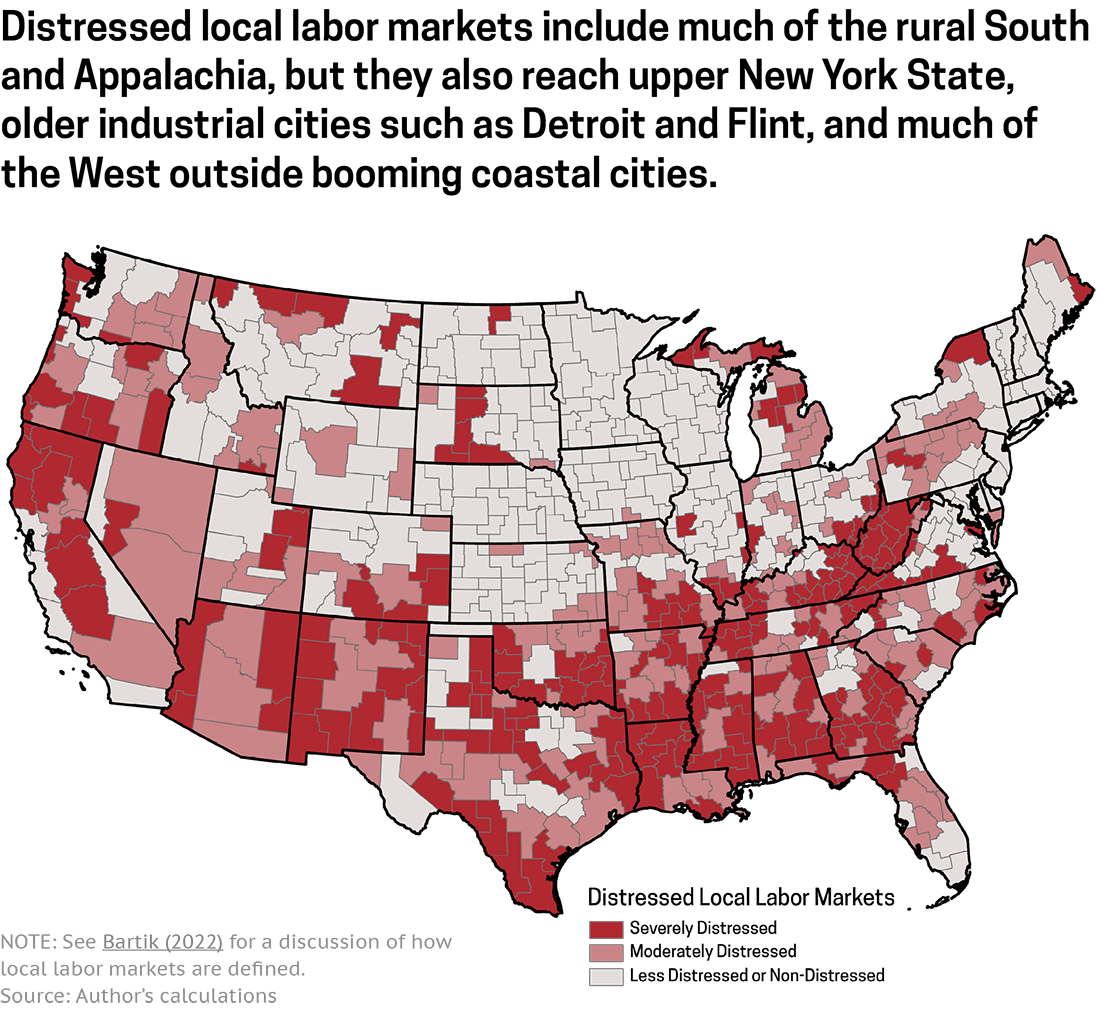
by Tim Bartik
Policy Recommendations
-
One of the best ways to help residents living in low-employment-rate labor markets is to encourage local job creation through customized business services.
-
This job creation does not have to be in the neighborhoods with low employment rates; rather, help residents access jobs throughout the local labor market.
-
States can accomplish both these goals by providing flexible block grants tied to the number of people in an area needing jobs.
Even when the overall U.S. unemployment rate is low, many Americans live in economically distressed places with low employment rates. These low employment rates can lead to lower earnings and social problems such as substance abuse, crime, and family breakups.
The distressed places problem exists on two levels, each of which requires different solutions.
The first level consists of distressed local labor markets, where employment rates are low throughout a multicounty area with extensive commuting, such as a metropolitan area or a rural commuting zone. About 1 in 10 Americans live in “severely distressed” local labor markets, where the employment rate is at least 10 percentage points below “full employment.” Full employment is defined here as the employment rate that is exceeded only by labor markets at the 90th percentile of the employment rate; that is, only 10 percent of the U.S. population lives in labor markets that exceed that rate, which appears to roughly define a maximum feasible employment rate. Another 30 percent of Americans live in “moderately distressed” local labor markets, those with employment rates at least 5 percentage points below full employment.

The second level of the distressed place problem consists of neighborhoods with low employment rates. If we define “neighborhood” as a census tract—government-defined areas that average about 4,000 people—then 1 in 10 Americans live in “distressed neighborhoods,” those with employment rates at least 10 percentage points below that of their local labor market. Distressed neighborhoods are prevalent in many older cities; for example, nearly half of Detroit’s population lives in a distressed neighborhood.
Low employment rates in distressed local labor markets generally have different causes and require different solutions than low employment rates in distressed neighborhoods. For distressed local labor markets, the problem is an overall lack of jobs. Creating additional jobs in the labor market as a whole can increase the local employment rate, and this can be done cost-effectively through job creation policies with high returns.
The most cost-effective local job creation policies provide customized business services. These types of services include
- focused job training programs in which community colleges provide free training to individual businesses;
- manufacturing extension services that work with small and medium-sized manufacturers to help them target new markets and adopt new technologies;
- small business development centers that advise entrepreneurs on starting and expanding businesses;
- road and transit improvements to support new business investments; and
- business, industrial, and research parks, which provide real estate already zoned and ready for development.
These services can create local jobs at a cost of around $55,000 per job, less than one-third the cost of job creation through business tax incentives.
In contrast, residents of low-employment-rate neighborhoods are not substantially helped by locating new jobs in the neighborhood, as most of a neighborhood’s jobs are not held by that neighborhood’s residents. What residents of distressed neighborhoods need is better access to jobs in the local labor market. Improving job access comes not only from expanding local transit or making it easier to purchase reliable used cars, but also through specialized employment services: better information on appropriate job openings, job training, child care, and success coaches to improve job retention. These services can help neighborhood residents get jobs at a cost of about $70,000 per extra job opportunity.
These costs of $55,000 or $70,000 per job may seem high, but they are significantly less than the social benefits the extra job opportunities provide. Besides the increase in individual earnings exceeding these costs over time, there are broader benefits for the family and society. States could significantly increase employment in distressed places at reasonable costs. I estimate that over 10 years, states could shrink the employment rate gap between these distressed places and full employment by one-third, at an annual cost of about $30 billion, or less than 3 percent of state tax revenues.
The barrier to greater state help for distressed places is political: states find it difficult to persistently target distressed places at sufficient scale. States have historically provided larger tax subsidies per job created in distressed places than in booming places. However, because booming places create more total jobs than distressed places, it is not uncommon for more total subsidy dollars to go to booming places. Other states have tried to limit eligibility for assistance to distressed places. But every place believes it needs jobs, so political pressures often lead to expanding eligibility to most or even all of a state.
To effectively target assistance to distressed places, I recommend a block grant approach in which funding is based on the size of the employment rate gap in a particular place. That is, states would seek to close a fraction of the employment rate gap between each place and some state goal. Most places in the state would receive some funds, but higher amounts would flow to places with lower employment rates. If an area had an employment rate gap twice as large as another, it would receive twice as great a block grant per capita. This targeting is straightforward: if we need to create twice as many job opportunities per capita in the distressed place, it should logically receive twice the per capita funds. Consequently, all places get some funds, but distressed places are guaranteed to get more dollars per capita.
This targeting approach already exists in other settings. For example, some states provide significant aid to K–12 students based on the number of students eligible for the National School Lunch Program. Nearly all school districts get something, but school districts with more low-income students get more. The targeting is thus transparent and fair.
If states are committed to helping all their residents get and keep good jobs, targeting distressed places represents an important way to achieve that goal. Although other policies—such as better education and training—can also help, directly creating job opportunities and making them more accessible to those who need them most yields benefits beyond jobs for the nonemployed. When more residents have good jobs, substance abuse and crime tend to fall and educational achievement tends to rise. These shifts boost state tax revenues while lowering Medicaid and criminal justice costs. They also set the stage for greater economic mobility and well-being for the next generation. Targeting distressed places therefore can pay off for the entire state.

